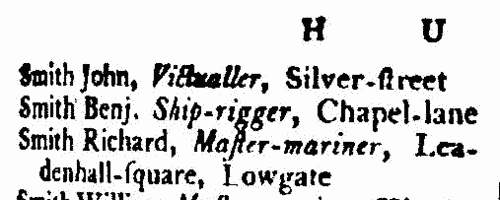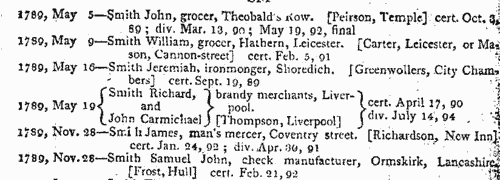Add this eBook to your basket to receive access to all 66 records. Our indexes include entries for the spelling myall. In the period you have requested, we have the following 66 records (displaying 11 to 20): These sample scans are from the original record. You will get scans of the full pages or articles where the surname you searched for has been found. Your web browser may prevent the sample windows from opening; in this case please change your browser settings to allow pop-up windows from this site.  Masters of apprentices registered in Dorset
(1794) Masters of apprentices registered in Dorset
(1794)
Apprenticeship indentures and clerks' articles were subject to a 6d or 12d per pound stamp duty: the registers of the payments usually give the master's trade, address, and occupation, and the apprentice's name, as well as details of the date and length of the apprenticeship. There are central registers for collections of the stamp duty in London, as well as returns from collectors in the provinces. These collectors generally received duty just from their own county, but sometimes from further afield. The indentures themselves can date from a year or two earlier than this return. (The sample entry shown on this scan is taken from a Bristol return. Each entry has two scans, the other being the facing page with the details of the indenture, length of service, and payment of duty.) IR 1/67 | Sample scan, click to enlarge

|  Apprentices registered in Derbyshire
(1796) Apprentices registered in Derbyshire
(1796)
Apprenticeship indentures and clerks' articles were subject to a 6d or 12d per pound stamp duty: the registers of the payments usually give the master's trade, address, and occupation, and the apprentice's name, as well as details of the date and length of the apprenticeship. There are central registers for collections of the stamp duty in London, as well as returns from collectors in the provinces. These collectors generally received duty just from their own county, but sometimes from further afield. The indentures themselves can date from a year or two earlier than this return. (The sample entry shown on this scan is taken from a Bristol return. Each entry has two scans, the other being the facing page with the details of the indenture, length of service, and payment of duty.) IR 1/68 | Sample scan, click to enlarge

| Inhabitants of Castle Hedingham in Essex
(1790-1797)
The provincial sections of the Universal British Directory include lists of gentry and traders from each town and the surrounding countryside, with names of local surgeons, lawyers, postmasters, carriers, &c. (the sample scan here is from the section for Hull). The directory started publication in 1791, but was not completed for some years, and the provincial lists, sent in by local agents, can date back as early as 1790 and as late as 1797.
| Sample scan, click to enlarge

| Traders and professionals in London
(1805)
Holden's Triennial Directory for 1805 to 1807 includes this 'London Alphabet of Businesses, Professions, &c.': coverage is good; about 30,000 individuals are recorded. | Sample scan, click to enlarge

| Bankrupts
(1786-1806)
William Smith's abstracts of bankrupts, dividends and certificates for England and Wales from 1786 to June 1806. Bankruptcy causes abrupt changes in people's lives, and is often the reason for someone appearing suddenly in a different location or in a different occupation. | Sample scan, click to enlarge

| Essex Freeholders: Hinckford hundred
(1810)
The poll of the freeholders of Essex at the election of a knight of the shire to serve in Parliament, taken at Chelmsford 31 January 1810 and fourteen following days (Sundays excepted). The candidates were John Archer Houblon esquire and Montagu Burgoyne esquire. This poll book gives the names of the voters arranged by initial letter of surname division by division. The freeholders' full names are stated, surname first, residence (often elsewhere), and place where the freehold lay. The right hand column records their votes. The qualification for suffrage in the counties was the possession of a freehold estate worth more than 40s a year. The electoral divisions comprised these hundreds: I. Barstable and Chafford; II. Becontree and Waltham; III. Chelmsford; IV. Hinckford; V. Tendring; VI. Uttleford, Clavering and Dunmow; VII. Harlow, Ongar and Freshwell; VIII. Lexden, Colchester and Witham; IX. Rochford and Thurstable; X. Dengie and Winstree. Hinckford hundred includes Braintree and Halstead.
| Sample scan, click to enlarge

| Insolvents
(1829)
Declarations of insolvency in England and Wales | Sample scan, click to enlarge

| Inhabitants of Devon
(1830)
Pigot & Co.'s National Commercial Directory lists traders, farmers and private residents in the county. | Sample scan, click to enlarge

| Electors of Broome
(1840)
The register of electors entitled to vote in any parliamentary election for East Norfolk between 1 November 1840 and 1 November 1841 lists 8,556 freeholders arranged by hundred and within hundred by parish or township &c. In the first column, after number within the register, the elector's name is given (surname first); the second column gives place of abode; the third column the nature of qualification (such as 'owner and occupier'); and the fourth column the address of the qualifying property, in some cases with the name of the tenant or occupier. | Sample scan, click to enlarge

| Officers and officials of English hospitals
(1841)
The Royal Kalendar lists patrons, governors, officers and staff of the hospitals and infirmaries in and near London: Saint Bartholomew's; the Bridewell and Bethlem; St Thomas's; Emanuel; Asylum for Poor French Protestants; Westminster Hospital; Guy's; Bancroft's Hospital; St George's; the Foundling Hospital; the London Hospital; the Hospital for Casual Smallpox and Vaccination; Lock Hospital; Middlesex Hospital; the British Lying-in Hospital for Married Women; the City of London Lying-in Hospital; St Luke's Hospital for Lunatics; Queen Charlotte's Lying-in Hospital; the Asylum for French Orphans; the General Lying-in Hospital; the Jews Hospital; Seamen's Hospital Society; Magdalen Hospital; London Fever Hospital; Royal London Ophthalmic Hospital; Royal Sea Bathing Infirmary (at Westbrook near Margate); Royal Infirmary for Diseases of the Eye; Royal Westminster Ophthalmic Hospital; Infirmary for Asthma, Consumption and other Diseases of the Lungs; Charing Cross Hospital and Medical College; the Royal Metropolitan Hospital for Children; the Royal Maternity Charity for delivering Poor Married Women at their own Habitations; the General Dispensary for Relief of the Poor; Westminster General Dispensary; London Dispensary; Finsbury Dispensary; the Eastern Dispensary; the Public Dispensary; Marylebone General Dispensary; Queen Adelaide and British Ladies Lying-in Institution; the City Dispensary; the Western Dispensary; Surrey Dispensary; Tower Hamlets Dispensary; Bloomsbury Dispensary; the National Truss Society; the Rupture Society for the Supply of Trusses to the Indigent Poor; the City of London Truss Society; the National Vaccine Establishment; the Charitable Fund and Dispensary for Relieving the Sick Poor at their own Habitations with Medicines and Pecuniary Aid; the Northern Dispensary; the Royal Infirmary for Children; the Royal Dispensary for the Diseases of the Ear, and the Deaf and Dumb; the Royal Jennerian and London Vaccine Institution for the Extermination of Smallpox, for Gratuitous Vaccination, and Keeping up a Genuine Ichor; and St George's and St James's Dispensary. | Sample scan, click to enlarge

|
Research your ancestry, family history, genealogy and one-name study by direct access to original records and archives indexed by surname.
|












